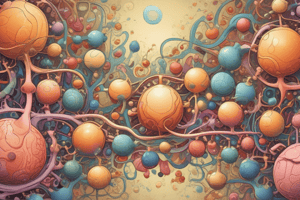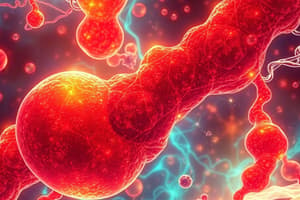Podcast
Questions and Answers
What is the primary role of fatty acids once they are taken up by cells?
What is the primary role of fatty acids once they are taken up by cells?
- To be immediately broken down into glucose for quick energy.
- To act solely as hormones regulating cellular communication.
- To serve as structural components of cell membranes exclusively.
- To function as precursors in the synthesis of other compounds, fuels for energy, and substrates for ketone body synthesis. (correct)
What percentage range of the daily caloric intake in the average American diet is typically derived from fats?
What percentage range of the daily caloric intake in the average American diet is typically derived from fats?
- 50-60%
- 5-15%
- 10-20%
- 30-40% (correct)
If the body's TAG (triacylglycerol) reserves are the primary source of energy, approximately how long could someone survive starvation, assuming they have average reserves?
If the body's TAG (triacylglycerol) reserves are the primary source of energy, approximately how long could someone survive starvation, assuming they have average reserves?
- About 3 days
- Approximately 2 weeks
- Around 30 days (correct)
- Roughly 60 days
What is the primary function of lipid metabolism in the body?
What is the primary function of lipid metabolism in the body?
What percentage of ingested lipids are triacylglycerols (TAGs)?
What percentage of ingested lipids are triacylglycerols (TAGs)?
What is the direct effect of lipid digestion in the mouth?
What is the direct effect of lipid digestion in the mouth?
What is ‘chyme’ in the context of lipid digestion within the stomach?
What is ‘chyme’ in the context of lipid digestion within the stomach?
Gastric lipase can hydrolyze approximately what percentage of TAGs in the stomach?
Gastric lipase can hydrolyze approximately what percentage of TAGs in the stomach?
What is the role of cholecystokinin (CCK) in lipid digestion?
What is the role of cholecystokinin (CCK) in lipid digestion?
What is the function of bile in the context of lipid digestion?
What is the function of bile in the context of lipid digestion?
How does pancreatic lipase aid in the digestion of triglycerides?
How does pancreatic lipase aid in the digestion of triglycerides?
What is the composition of the remaining molecule after partial hydrolysis of triacylglycerols by pancreatic lipase?
What is the composition of the remaining molecule after partial hydrolysis of triacylglycerols by pancreatic lipase?
What structural feature characterizes the interior of fatty acid micelles?
What structural feature characterizes the interior of fatty acid micelles?
After absorption into intestinal cells, what are free fatty acids and monoacylglycerols re-formed into?
After absorption into intestinal cells, what are free fatty acids and monoacylglycerols re-formed into?
What are chylomicrons and what is their role in lipid transport?
What are chylomicrons and what is their role in lipid transport?
Where do triacylglycerols go after reaching the bloodstream via chylomicrons?
Where do triacylglycerols go after reaching the bloodstream via chylomicrons?
Which of the following is the correct order of events that must occur before triacylglycerols (TAGs) can reach the bloodstream through the digestive process?
Which of the following is the correct order of events that must occur before triacylglycerols (TAGs) can reach the bloodstream through the digestive process?
What is the primary role of adipocytes in the body?
What is the primary role of adipocytes in the body?
What is the main function of lipolysis?
What is the main function of lipolysis?
Which hormones promote lipolysis, the breakdown of fat, in the body?
Which hormones promote lipolysis, the breakdown of fat, in the body?
What is the role of insulin in lipolysis?
What is the role of insulin in lipolysis?
In fatty acid transport, what special protein aids fatty acids to be transferred to the skeletal muscle?
In fatty acid transport, what special protein aids fatty acids to be transferred to the skeletal muscle?
Why can't fatty acids be metabolized for energy production within the cytosol?
Why can't fatty acids be metabolized for energy production within the cytosol?
What is the function of the carnitine shuttle system in fatty acid metabolism?
What is the function of the carnitine shuttle system in fatty acid metabolism?
What is the role of Acyl-CoA synthetase in fatty acid transport?
What is the role of Acyl-CoA synthetase in fatty acid transport?
Which molecule must long-chain fatty acids be conjugated to, so as to cross the inner mitochondrial membrane?
Which molecule must long-chain fatty acids be conjugated to, so as to cross the inner mitochondrial membrane?
What is the function of carnitine-acylcarnitine translocase?
What is the function of carnitine-acylcarnitine translocase?
What products are generated during each beta-oxidation cycle?
What products are generated during each beta-oxidation cycle?
What happens to the high-energy electrons from NADH and FADH2 produced during beta-oxidation?
What happens to the high-energy electrons from NADH and FADH2 produced during beta-oxidation?
Where does beta-oxidation link to the citric acid cycle (CAC)?
Where does beta-oxidation link to the citric acid cycle (CAC)?
What process is carried out by Acyl-CoA dehydrogenase?
What process is carried out by Acyl-CoA dehydrogenase?
What role does the enzyme Enoyl-CoA hydratase perform in beta-oxidation?
What role does the enzyme Enoyl-CoA hydratase perform in beta-oxidation?
What role does hydroxyl acyl CoA dehydrogenase perform in beta oxidation?
What role does hydroxyl acyl CoA dehydrogenase perform in beta oxidation?
What role does keto acyl-CoA thiolase perform in beta oxidation?
What role does keto acyl-CoA thiolase perform in beta oxidation?
What is the purpose of beta oxidation?
What is the purpose of beta oxidation?
What is the starting material for lipolysis?
What is the starting material for lipolysis?
How is lipolysis connected to lipogenesis?
How is lipolysis connected to lipogenesis?
What happens to Glycerol, after it's been cleaved from a Triacylglycerol?
What happens to Glycerol, after it's been cleaved from a Triacylglycerol?
Dihydroxyacetone phosphate is an intermediate for which other metabolic pathways?
Dihydroxyacetone phosphate is an intermediate for which other metabolic pathways?
Flashcards
Dietary Fats
Dietary Fats
Fats are a crucial source of calories in the diet.
Lipid Metabolism
Lipid Metabolism
Lipid metabolism involves oxidizing fatty acids for energy or synthesizing new lipids.
Lipid Digestion
Lipid Digestion
This process begins in the mouth and stomach, but primarily occurs in the small intestine.
Ingested Lipids
Ingested Lipids
Signup and view all the flashcards
Gastric Lipase
Gastric Lipase
Signup and view all the flashcards
Pancreatic Lipases
Pancreatic Lipases
Signup and view all the flashcards
Bile Salts
Bile Salts
Signup and view all the flashcards
Micelles
Micelles
Signup and view all the flashcards
Chylomicrons
Chylomicrons
Signup and view all the flashcards
Triacylglycerols (TAGs)
Triacylglycerols (TAGs)
Signup and view all the flashcards
Adipocytes
Adipocytes
Signup and view all the flashcards
Lipolysis
Lipolysis
Signup and view all the flashcards
Hormones that promote lipolysis
Hormones that promote lipolysis
Signup and view all the flashcards
Triglycerides
Triglycerides
Signup and view all the flashcards
Hydrolysis
Hydrolysis
Signup and view all the flashcards
ATGL
ATGL
Signup and view all the flashcards
Hormone Sensitive Lipase
Hormone Sensitive Lipase
Signup and view all the flashcards
Monoglyceride Lipase
Monoglyceride Lipase
Signup and view all the flashcards
Adrenaline, Cortisol, Glucagon.
Adrenaline, Cortisol, Glucagon.
Signup and view all the flashcards
Insulin or Ketones.
Insulin or Ketones.
Signup and view all the flashcards
Fatty Acids
Fatty Acids
Signup and view all the flashcards
How Fats are transported to skeletal muscle
How Fats are transported to skeletal muscle
Signup and view all the flashcards
Mitochondria
Mitochondria
Signup and view all the flashcards
Transport for long-chain fatty acids
Transport for long-chain fatty acids
Signup and view all the flashcards
L-carnitine
L-carnitine
Signup and view all the flashcards
Acyl-CoA synthetase
Acyl-CoA synthetase
Signup and view all the flashcards
Fatty Acid Transport
Fatty Acid Transport
Signup and view all the flashcards
Carnitine-acylcarnitine translocate
Carnitine-acylcarnitine translocate
Signup and view all the flashcards
Beta-Oxidation
Beta-Oxidation
Signup and view all the flashcards
High energy electrons
High energy electrons
Signup and view all the flashcards
Citric Acid Cycle
Citric Acid Cycle
Signup and view all the flashcards
Enzyme Involved in Beta Oxidation
Enzyme Involved in Beta Oxidation
Signup and view all the flashcards
Enzyme involved in beta-oxidation
Enzyme involved in beta-oxidation
Signup and view all the flashcards
Hydroxyl acyl CoA.
Hydroxyl acyl CoA.
Signup and view all the flashcards
Keto Acyl-CoA
Keto Acyl-CoA
Signup and view all the flashcards
Ketone Bodies
Ketone Bodies
Signup and view all the flashcards
Ketone Synthesis
Ketone Synthesis
Signup and view all the flashcards
Fats in Fat-Cells
Fats in Fat-Cells
Signup and view all the flashcards
Study Notes
Structure of Fatty Acids
- Dietary fats and oils are key components in fat metabolism.
Overview of Fat Metabolism
- Fatty acids are absorbed by cells, where they act as precursors for synthesizing compounds, energy fuels, and substrates for ketone body synthesis.
- Ketone bodies are energy sources which can be transported to other tissues.
- Some cells can synthesize and export fatty acids for storage.
Energy from Fat
- Fats significantly contribute to calorie intake, making up 30-40% of the standard American diet.
- Primarily stored as fat, the body's fuel reserves include 100,000 kcal of fat, 25,000 kcal of protein, and 650 kcal of carbohydrates.
- Fat supplies 60% of the body's energy while resting.
- Stored triacylglycerols can sustain someone through about 30 days of starvation.
- Lipid metabolism oxidizes fatty acids to produce energy or synthesize new lipids from smaller molecules
- It links with carbohydrate metabolism via acetyl CoA, converted from glucose.
Digestion and Absorption of Lipids
- Ingested lipids are 98% triacylglycerols (TAGs).
- Digestion starts in the mouth with aqueous enzymes, having little effect on lipids.
- The stomach physically changes lipids by churning them into droplets called "Chyme".
- Gastric lipase initiates lipid digestion in the stomach, hydrolyzing about 10% of TAGs.
- Intestinal Chyme stimulates cholecystokinin (CCK) release, prompting the gallbladder to release bile, which acts as an emulsifier, breaking down fats.
- Pancreatic lipase (PL) binds to bile-salt micelles to hydrolyze insoluble triglycerides which results in 2 of the 3 fatty acids being released.
- The remaining structure is monoacylglycerol = glycerol and 1 fatty acid.
- Oil droplets form spherical micelles through the help of bile salts and fatty acids.
- Hydrophobic fatty acids and monoacylglycerols accumulate in the micelle's interior.
- Bile salts are located on the exterior.
- Micelles facilitate the transport through the intestinal cell membrane.
- After transport free fatty acids & monoacylglycerols reform into triacylglycerols.
- TAGs combine with proteins to form chylomicrons (lipoproteins).
- Chylomicrons transport TAGs from intestinal cells into the bloodstream via the lymphatic system.
- In the bloodstream, triacylglycerols break down into glycerol and fatty acids for cell absorption.
- Absorbed molecules transform into acetyl CoA for energy or stored as lipids in adipose tissue.
Adipocytes
- Adipocytes, found mostly in the abdominal cavity and subcutaneous tissue, store energy, provide insulation, and act as shock absorbers
- They constantly hydrolyze and resynthesize triacylglycerols
Hormonal Control of Lipolysis
- The breakdown of triglycerides via lipases is hormonally regulated by epinephrine, glucagon, and insulin.
- Epinephrine and glucagon trigger fat breakdown (lipolysis), whereas insulin inhibits it.
Lipolysis
- This process breaks down fats, specifically triglycerides, within adipose tissue.
- Ester bonds must be cleaved via hydrolysis, using water for a chemical reaction.
- The complete process has three steps, each detaching a fatty acid from the glycerol backbone.
- This requires 3 separate enzymes and 3 water molecules:
- adipose triglyceride lipase breaks the first ester bond leaving a diglyceride.
- hormone-sensitive lipase facilitates the reaction for the second ester bond forming a monoglyceride.
- monoglyceride lipase, facilitates the hydrolysis of the middle ester bond producing glycerol (alcohol).
- Adrenaline, Cortisol, and Glucagon stimulate lipolysis while insulin and ketones suppress it.
Fatty Acid Transport
- Fatty acids released from lipolysis are transported via plasma albumin, then transferred to skeletal muscle using the CD36 protein.
- Fatty acids cannot be metabolized for energy in the cytosol and must go to the mitochondria.
- Fat metabolism involves transporting fatty acids from the cytosol through the mitochondrial membranes into the mitochondrial matrix for beta-oxidation and ATP production.
- Short and medium fatty acids freely cross membranes, but longer fatty acids require the carnitine shuttle transport system.
- L-carnitine, a dipeptide, is made in the liver from lysine and methionine for use in the transport system.
- The carnitine shuttle proceeds via:
- Activation where fatty acids combine with coenzyme A and Acyl-CoA synthetase, producing acyl coenzyme A.
- Acyl-CoA synthetase enzymes activate fatty acids and are located in the outer mitochondrial membrane.
- The Acyl group representing the long-chain FA conjugates with carnitine producing Acyl-Carnitine Acyl Carnitine is transported across the inner mitochondrial membrane via carnitine-acylcarnitine translocase, liberating coenzyme A.
- The dislodged coenzyme A returns to activate another fatty acid in the previous step, while the remaining acyl group combines with another coenzyme A within the matrix to reproduce acyl coenzyme A for beta-oxidation.
Beta-Oxidation
-
Each beta-oxidation cycle produces one reduced coenzyme FADH2 and one reduced coenzyme NADH at steps 1 and 3.
-
These coenzymes link to the electron transport chain, offload electrons and hydrogen, and return as FAD and NAD+ to repeat the cycle.
-
High-energy electrons from NADH and FADH2 fuel the electron transport chain, driving ATP production through oxidative phosphorylation.
-
Beta-oxidation links to the citric acid cycle through acetyl CoA produced during beta-oxidation which acts as an entry point.
-
This process involves cleaving and removing an acetyl group through oxidation.
-
Acyl-CoA dehydrogenase catalyzes the first step, removing hydrogens to create FADH2.
-
Enoyl-CoA hydratase catalyzes the second step as water is added, producing a secondary alcohol.
-
Hydroxyl Acyl CoA dehydrogenase catalyzes the third step where the H is removed from the OH group and is then attached to the beta carbon
-
Keto acyl-CoA thiolase catalyzes the fourth and final step where a two-carbon acetyl segment is cleaved away with coenzyme A.
-
The remaining fragment combines with S-CoA, forming a six-carbon fatty acyl CoA product which then repeats the cycle.
-
In a Fatty Acid:
- Each acetyl CoA is 10 ATP
- Each cycle creates 1 FADH2 and 1 NADH
- For odd numbers one propionyl yields 5 ATP
- If there is an incomplete cycle (double bond) then there is no FADH2 production
- Activation costs 2 ATP
Distribution and Metabolism of Glycerol
- One glycerol molecule is formed for each hydrolyzed TAG.
- Glycerol enters the bloodstream and is processed in the liver or kidneys.
- It converts to dihydroxyacetone phosphate in two steps.
- Triacylglycerol lipase, Diacyclglycerol lipase and Monoacylglycerol lipase.
- Only triacylglycerol lipase is activated by epinephrine.
- ATP is used to reduce NAD+ to NADH.
- The primary hydroxyl group is phosphorylated
- Ketones are formed during oxidation.
- Dihydroxyacetone phosphate, an intermediate, connects lipid and carbohydrate metabolism:
- Through Glycolysis, it converts to Pyruvate, forming Acetyl CoA and releasing energy.
- Through Gluconeogenesis, it synthesizes Glucose from non-carbohydrate sources.
Ketone Bodies
- A process that requires:
- Acetyl CoA Acyl Transferase
- HMG CoA synthase
- HMG CoA Lyase
- Beta hydroxyl butyrate dehydrogenase
- Acetoacetate decarboxylase
- CoA transferase
- Thiolase
- This creates:
- Acetoacetate
- 3-Hydroxybutyrate
- Acetone
- They are water soluble, easily transportable, and synthesized in the liver.
Studying That Suits You
Use AI to generate personalized quizzes and flashcards to suit your learning preferences.





